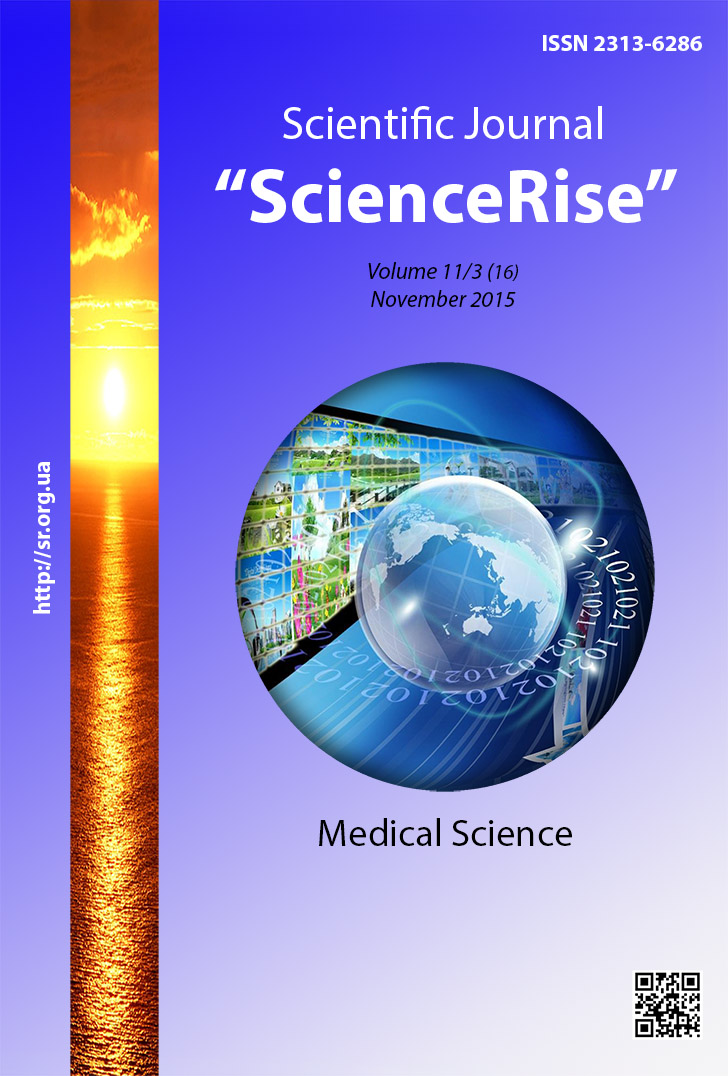Вплив поліморфізму гену COL1A1 на стан опорно-рухового апарату та серцево-судинну систему
DOI :
https://doi.org/10.15587/2313-8416.2015.53668Mots-clés :
спортсмени, дисплазія сполучної тканини, колаген І типу, поліморфізм, ген COL1A1Résumé
Метою дослідження стало удосконалення медичного забезпечення тренувального процесу спортсменів з урахуванням впливу поліморфізму гену COL1A1 на розвиток ознак дисплазії сполучної тканини. Було обстежено 85 осіб, з поліморфізмом rs 1800012 гену COL1A1. Встановлено, що генотип ТТ проявляється доліхостеномелією, гіпермобільністю суглобів, збільшенням частоти деформацій хребта та змінами морфології та діастолічної функції серця
Références
Kaduryna, T. Y., Gnusaev, S. F., Аbbakumova, L. N., et al. (2014). Nasledstvennye i mnogofaktornye narusheniya soedinitel'noy tkani u detey. Algoritmy diagnostiki, taktika vedeniya [Heritable and multifactorial disorders of connective tissue in children. Diagnostic algorithms, tactic]. Pediatrics, 93 (5), 1–40.
Veit, G., Kobbe, B., Keene, D. R., Paulsson, M., Koch, M., Wagener, R. (2005). Collagen XXVIII, a Novel von Willebrand Factor A Domain-containing Protein with Many Imperfections in the Collagenous Domain. Journal of Biological Chemistry, 281 (6), 3494–3504. doi: 10.1074/jbc.M509333200
Jin, H., van’t Hof, R. J., Albagha, O. M. E., Ralston, S. H. (2009). Promoter and intron 1 polymorphisms of COL1A1 interact to regulate transcription and susceptibility to osteoporosis. Human Molecular Genetics, 18 (15), 2729–2738. doi: 10.1093/hmg/ddp205
Dehghan, M., Pourahmad-Jaktaji, R. (2015). Sp1 binding site polymorphism of a collagen gene (rs 1800012) in womenaged 45 and over and its association with bone density. Turkish Journal of Medical Sciences, 45, 644–650. doi: 10.3906/sag-1405-80
Shilina, E. Yu., Sorokina, T. A., Ivanushkina, N. M., et al. (2015). The study of rs1800012 polymorphism of the alpha1-chain collagen type 1 gene in moscow women and children with different level of bone strength. Eating questions, 4, 74–81.
Hoffmann, A., Gross, G. (2009). Innovative Strategies for Treatment of Soft Tissue Injuries in Human and Animal Athletes. Medicine and Sport Science, 54, 150–165. doi: 10.1159/000235702
Posthumus, M., September, A. V., Keegan, M., O’Cuinneagain, D., Van der Merwe, W., Schwellnus, M. P., Collins, M. (2009). Genetic risk factors for anterior cruciate ligament ruptures: COL1A1 gene variant. British Journal of Sports Medicine, 43 (5), 352–356. doi: 10.1136/bjsm.2008.056150
Sezer, S., Şimşek, N., Çelik, H. T., Erden, G., Ozturk, G., Düzgün, A. P., Çoşkun, F., Demircan, K. (2013). Association of collagen type I alpha 1 gene polymorphism with inguinal hernia. Hernia, 18 (4), 507–512. doi: 10.1007/s10029-013-1147-y
Ferrari, M. M., Rossi, G., Biondi, M. L., Viganò, P., Dell’Utri, C., Meschia, M. (2011). Type I collagen and matrix metalloproteinase 1, 3 and 9 gene polymorphisms in the predisposition to pelvic organ prolapse. Archives of Gynecology and Obstetrics, 285 (6), 1581–1586. doi: 10.1007/s00404-011-2199-9
Antoniou, G. A., Georgiadis, G. S., Antoniou, S. A., Granderath, F. A., Giannoukas, A. D., Lazarides, M. K. (2011). Abdominal aortic aneurysm and abdominal wall hernia as manifestations of a connective tissue disorder. Journal of Vascular Surgery, 54 (4), 1175–1181. doi: 10.1016/j.jvs.2011.02.065
Smolenskyj, A. V., Myhajlova, A. V. (2007). Osnovnye napravleniya razvitiya sportivnoy meditsiny na sovremennom etape [Main directions of development of sports medicine at the present stage]. Sports medicine, 2, 3–9.
Bonow, R., Cheitlin, M., Crawford, M., Douglas, P. (2005). Eligibility Recommendations for Competitive Athletes With Cardiovascular Abnormalities. Journal of the American College of Cardiology, 45 (8), 1312. doi: 10.1016/j.jacc.2005.02.002
Garcia-Campayo, J., Asso, E., Alda, M. (2010). Joint Hypermobility and Anxiety: The State of the Art. Current Psychiatry Reports, 13 (1), 18–25. doi: 10.1007/s11920-010-0164-0
Beighton, Р., Grahame, R., Bird, H. (2012). Hypermobility of Joints. New York: Springer, 204. doi: 10.1007/978-1-84882-085-2
Kovalenko, V. M., Lutaj, M. I., Bratus', V. V. et. al.; Kovalenkao, V. M. (Ed.) (2009). Nastanova z kardiologii' [Guide for cardiology]. Kyiv: МОRІОN, 1368.
Evangelista, A., Flachskampf, F., Lancellotti, P., Badano, L., Aguilar, R., Monaghan, M. et. al (2008). European Association of Echocardiography recommendations for standardization of performance, digital storage and reporting of echocardiographic studies. European Journal of Echocardiography, 9 (4), 438–448. doi: 10.1093/ejechocard/jen174
Nagueh, S. F., Appleton, C. P., Gillebert, T. C., Marino, P. N., Oh, J. K., Smiseth, O. A. et. al (2008). Recommendations for the Evaluation of Left Ventricular Diastolic Function by Echocardiography. European Journal of Echocardiography, 10 (2), 165–193. doi: 10.1093/ejechocard/jep007
Аkhmetov, I. I. (2009). Molekulyarnaya genetika sporta: monografiya [Molecular genetics of sport]. Moscow: Soviet sport, 268.
Halafyan, A. A. (2007). STATISTICA 6. Statisticheskiy analiz dannykh [STATISTICA 6. The statistical analysis of the data]. Moscow: Open Company "Binom-press", 512.
Arsent'ev, V. G., Aseev, M. V., Baranov, V. S., Shabalov, N. P. (2013). Rezul'taty molekulyarno-geneticheskogo obsledovaniya detey s displaziey soedinitel'noy tkani [The results of molecular genetic testing of children with connective tissue dysplasia]. Pediatrics. Journal of G. N. Speranskii, 92 (4), 27–30.
Téléchargements
Publié-e
Numéro
Rubrique
Licence
(c) Tous droits réservés Олег Борисович Неханевич 2015

Cette œuvre est sous licence Creative Commons Attribution 4.0 International.
Our journal abides by the Creative Commons CC BY copyright rights and permissions for open access journals.
Authors, who are published in this journal, agree to the following conditions:
1. The authors reserve the right to authorship of the work and pass the first publication right of this work to the journal under the terms of a Creative Commons CC BY, which allows others to freely distribute the published research with the obligatory reference to the authors of the original work and the first publication of the work in this journal.
2. The authors have the right to conclude separate supplement agreements that relate to non-exclusive work distribution in the form in which it has been published by the journal (for example, to upload the work to the online storage of the journal or publish it as part of a monograph), provided that the reference to the first publication of the work in this journal is included.

